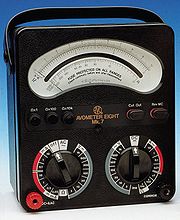
Avometer
Encyclopedia

Multimeter
A multimeter or a multitester, also known as a VOM , is an electronic measuring instrument that combines several measurement functions in one unit. A typical multimeter may include features such as the ability to measure voltage, current and resistance...
, latterly owned by Megger. The most widespread of the range was the Model 8, which was produced in various versions from the 1950s until 2008, the last version being the Mark 7.
It is often called simply an AVO and derives its name from the first letter of the words ampere
Ampere
The ampere , often shortened to amp, is the SI unit of electric current and is one of the seven SI base units. It is named after André-Marie Ampère , French mathematician and physicist, considered the father of electrodynamics...
s, volt
Volt
The volt is the SI derived unit for electric potential, electric potential difference, and electromotive force. The volt is named in honor of the Italian physicist Alessandro Volta , who invented the voltaic pile, possibly the first chemical battery.- Definition :A single volt is defined as the...
s, ohm
Ohm
The ohm is the SI unit of electrical resistance, named after German physicist Georg Simon Ohm.- Definition :The ohm is defined as a resistance between two points of a conductor when a constant potential difference of 1 volt, applied to these points, produces in the conductor a current of 1 ampere,...
s. It was conceived by the Post Office engineer Donald Macadie in 1923.
Technical features
It was by far the best instrument of its kind in the UK from 1923 to at least the 1960s. Almost uniquely for a radio repairman's multimeter it measures alternating currentAlternating current
In alternating current the movement of electric charge periodically reverses direction. In direct current , the flow of electric charge is only in one direction....
up to 10 A as well as AC and DC
Direct current
Direct current is the unidirectional flow of electric charge. Direct current is produced by such sources as batteries, thermocouples, solar cells, and commutator-type electric machines of the dynamo type. Direct current may flow in a conductor such as a wire, but can also flow through...
voltages up to at least 1000 V. The Model 8 Mk. V included additional inputs to measure up to 3000 V. As an ohmeter it measures from 0.1 Ω up to 200 kΩ in three ranges. The instrument has an accuracy of ±1% of FSD
Full scale
In electronics and signal processing, full scale or full code represents the maximum amplitude a system can present.-Electronics and signal processing:...
on DC ranges and ±2% on AC ranges. Its maximum current draw of 50 μA at full-scale deflection (corresponding to 20,000 ohms per volt) is sufficient in most cases to reduce voltage measurement error due to circuit loading by the meter to an acceptable level. A pair of rotary switches are used to select the range to be measured, being arranged in such a way as to minimise the risk of damage to the instrument should the wrong range be selected. Further protection is provided by an overload cut-out and fuses. It was a superb example of British radio engineering in its heyday and was found in many R&D laboratories and virtually every radio repair workshop throughout the country. Even nowadays it can still be found in regular use.

